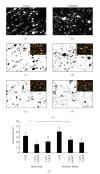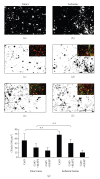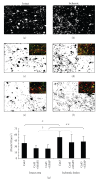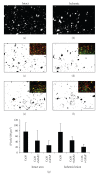Ischemia alters the expression of connexins in the aged human brain
- PMID: 19794823
- PMCID: PMC2753779
- DOI: 10.1155/2009/147946
Ischemia alters the expression of connexins in the aged human brain
Abstract
Although the function of astrocytic gap junctions under ischemia is still under debate, increased expression of connexin 43 (Cx43) has been observed in ischemic brain lesions, suggesting that astrocytic gap junctions could provide neuronal protection against ischemic insult. Moreover, different connexin subtypes may play different roles in pathological conditions. We used immunohistochemical analysis to investigate alterations in the expression of connexin subtypes in human stroke brains. Seven samples, sectioned after brain embolic stroke, were used for the analysis. Data, evaluated semiquantitatively by computer-assisted densitometry, was compared between the intact hemisphere and ischemic lesions. The results showed that the coexpression of Cx32 and Cx45 with neuronal markers was significantly increased in ischemic lesions. Cx43 expression was significantly increased in the colocalization with astrocytes and relatively increased in the colocalization with neuronal marker in ischemic lesions. Therefore, Cx32, Cx43, and Cx45 may respond differently to ischemic insult in terms of neuroprotection.
Figures





References
-
- Araque A, Parpura V, Sanzgiri RP, Haydon PG. Tripartite synapses: glia, the unacknowledged partner. Trends in Neurosciences. 1999;22(5):208–215. - PubMed
-
- Dermietzel R, Spray DC. From neuro-glue (‘Nervenkitt’) to glia: a prologue. Glia. 1998;24(1):1–7. - PubMed
-
- Giaume C, Fromaget C, El Aoumari A, Cordier J, Glowinski J, Gros D. Gap junctions in cultured astrocytes: single-channel currents and characterization of channel-forming protein. Neuron. 1991;6(1):133–143. - PubMed
-
- Naus CCG, Bechberger JF, Caveney S, Wilson JX. Expression of gap junction genes in astrocytes and C6 glioma cells. Neuroscience Letters. 1991;126(1):33–36. - PubMed
-
- Siushansian R, Bechberger JF, Cechetto DF, Hachinski VC, Naus CCG. Connexin43 null mutation increases infarct size after stroke. Journal of Comparative Neurology. 2001;440(4):387–394. - PubMed
MeSH terms
LinkOut - more resources
Full Text Sources
Medical
Miscellaneous

